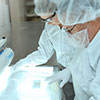Mass+Spectrometry
Catalog Number:
(10096-328)
Supplier:
Proteintech
Description:
TRIM24, also named as RNF82, TIF1 and TIF1A, interacts selectively in vitro with the AF2-activating domain of the estrogen receptors. Association with DNA-bound estrogen receptors, it requires the presence of estradiol. It is a regulation protein of P53. Defects in TRIM24 are a cause of thyroid papillary carcinoma (TPC) wich is a common tumor of the thyroid that typically arises as an irregular, solid or cystic mass from otherwise normal thyroid tissue.
Catalog Number:
(10096-802)
Supplier:
Proteintech
Description:
BUP1(Beta-ureidopropionase) is also named as BUP1, Beta-alanine synthase, N-carbamoyl-beta-alanine amidohydrolase and belongs to the CN hydrolase family. It catalyzes the last step in the pyrimidine degradation pathway that it converts N-carbamyl-beta-aminoisobutyric acid and N-carbamyl-beta-alanine to, respectively, beta-aminoisobutyric acid and beta-alanine, ammonia and carbon dioxide. It is a protein with a calculated molecular mass of 43 kDa.
Supplier:
PERKINELMER SCIENTIFIC CANADA ULC
Description:
These transversely-heated graphite tubes are made from a blend of high-quality base graphite material, providing the user with the required performance to yield reproducible results from day to day with respect to sensitivity (characteristic mass), accuracy and precision.
Catalog Number:
(89364-654)
Supplier:
Genetex
Description:
Stage-specific embryonic antigen (SSEA)-5 is an H type-1 glycan that is highly and specifically expressed on human embryonic stem cells (hESCs), the human blastocyst inner cell mass and undifferentiated human pluripotent stem cells (hPSCs). Expression of SSEA-5 in hESCs and hPSCs rapidly decreases upon differentiation and is considered an indicator of undifferentiated PSCs. This SSEA-5 antibody is capable of identifying undifferentiated pluripotent stem cells in heterogeneous populations, and when used in conjunction with other pluripotency surface markers (CD9 and CD90 or CD50 and CD200), it can be used to immunodeplete residual teratoma-causing cells from incompletely differentiated embryonic stem cell cultures.
Catalog Number:
(10750-492)
Supplier:
Prosci
Description:
FTO Antibody: Rising obesity rates are rapidly becoming a growing health concern in the developing world. The fat mass and obesity associated gene (FTO) is the first gene discovered to contribute to common forms of human obesity. FTO is a member of the non-heme dioxygenase superfamily, encoding a 2-oxoglutarate-dependent nucleic acid demethylase whose mRNA is widely expressed, especially in neurons of feeding-related nuclei of the brain. FTO mRNA in the arcuate nucleus in mice is up-regulated by feeding and down-regulated during fasting, although the opposite pattern has been observed in rats. At least four isoforms of FTO are known to exist.
Catalog Number:
(10105-784)
Supplier:
Prosci
Description:
The p70/p80 autoantigen is a nuclear complex consisting of two subunits with molecular masses of approximately 70 and 80 kDa. The complex functions as a single-stranded DNA-dependent ATP-dependent helicase. The complex may be involved in the repair of nonhomologous DNA ends such as that required for double-strand break repair, transposition, and V (D)J recombination. High levels of autoantibodies to p70 and p80 have been found in some patients with systemic lupus erythematosus.
Catalog Number:
(10094-256)
Supplier:
Proteintech
Description:
EXOC2 (exocyst complex component 2), also known as SEC5 and SEC5L1, is a component of the exocyst complex, and is required to mediate RalB-dependent survival signals in transformed cells. The exocyst complex, composed of eight evolutionarily conserved subunits (SEC3, SEC5, SEC6, SEC8, SEC10, SEC15, EXO70, and EXO84), is involved in tethering post-Golgi secretory vesicles to specific plasma membrane domains. The gene of EXOC2 maps to chromosome 6p25.3, and encodes a 924-amino acid protein with an experimentally determined molecular mass of 95-100 kDa. EXOC2 mRNA is widely expressed with highest levels in brain and placenta.
Catalog Number:
(10087-862)
Supplier:
Proteintech
Description:
GRHPR(Glyoxylate reductase/hydroxypyruvate reductase) is also named as GLXR and belongs to the D-isomer specific 2-hydroxyacid dehydrogenase family. The GRHPR gene encodes a predicted 328-amino acid protein with a calculated molecular mass of 35.5 kD. It has glyoxylate reductase (GR), hydroxypyruvate reductase (HPR) and D-glycerate dehydrogenase (DGDH) activities. Defects in GRHPR are the cause of hyperoxaluria primary type 2 (HP2). It can exsit as a homodimer.
Catalog Number:
(10782-032)
Supplier:
Biosensis
Description:
Nerve growth factor receptor (NGFR) is also referred to as p75(NTR) due to its molecular mass and its ability to bind at low affinity not only NGF (see 162030), but also other neurotrophins, including brain-derived neurotrophic factor (BDNF; 113505), neurotrophin-3 (NTF3; 162660), and neurotrophin-4/5 (NTF5; 162662). At the time of its discovery, NGFR was considered a unique type of protein. Subsequently, however, a large superfamily of tumor necrosis factor receptors were found to share the overall structure of NGFR (4 extracellular ligand-binding, cysteine-rich repeats, or CRs, and signaling through association with, or disassociation from, cytoplasmic interactors). The identification of this superfamily helped elucidate some of the biologic functions of NGFR, including its ultimate involvement in the nuclear factor kappa-B (NFKB; see 164011) and apoptosis pathways. As a monomer, NGFR binds NGF with low affinity. Higher affinity binding is achieved by association with higher molecular mass, low-affinity neurotrophin receptors, namely the tropomyosin receptor kinases, TRKA (NTRK1; 191315), TRKB (NTRK2; 600456), and TRKC (NTRK3; 191316). TRKA, TRKB, and TRKC are specific for or 'preferred by' NGF, NTF5 and BDNF, and NTF3, respectively. NTF3 also binds to TRKA and TRKB, but with significantly lower affinity.
Catalog Number:
(10072-646)
Supplier:
Prosci
Description:
Platelet Activating Factor (PAF) is a biologically active phospholipid, which exerts primarily proinflammatory activities by specifically signaling through G-protein-coupled receptors on platelets, neutrophils, and monocytes. Platelet Activating Factor Acetylhydrolase (PAF-AH) is a secreted protein that mediates PAF activity by specifically catalyzing hydrolysis of the "sn2” ester bond, resulting in the conversion of PAF to the biologically inactive lyso-PAF. PAF-AH can also interact with LDL particles to induce the hydrolysis of LDL associated, oxidized phospholipids, generating lysophosphatidylcholine (lyso-PC) and other lysophospholipids. Recombinant PAF-AH is a 420 amino acid glycoprotein which migrates with an apparent molecular mass of 47-55 kDa by SDS-PAGE analysis.
Catalog Number:
(10082-388)
Supplier:
Proteintech
Description:
Acyl-CoA dehydrogenases (ACADs) are a family of mitochondrial enzymes catalyzing the initial rate-limiting step in the β-oxidation of fatty acyl-CoA. ACAD9 belongs to the group of ACADs. The deduced 621-amino acid protein has a calculated molecular mass of 68.8 kD. It has an N-terminal leader sequence, 2 conserved motifs shared by all ACAD family members, and a potential N-glycosylation site. Defects in ACAD9 are a cause of acyl-CoA dehydrogenase family member type 9 deficiency (ACAD9 deficiency).
Catalog Number:
(10090-812)
Supplier:
Proteintech
Description:
Prelamin A, is processed in the nucleus to lamin A by removal of its final 18 amino acids, including the cysteine residue in its C-terminal CAAX box, which is farnesylated. Nuclear prelamin A recognition factor (NARF) binds the farnesylated prelamin A C-terminal domain(preAct). NARF, at 52 kDa, also named as IOP2, is a small enough protein to freely diffuse through the nuclear pore complex and may be retained within the nucleus by binding nuclear proteins and it has all of the information necessary to be imported into the nucleus. It has 3 isoforms produced by alternative splicing with the molecular mass of 51 kDa, 56 kDa and 46 kDa,respectively.
Catalog Number:
(10084-094)
Supplier:
Proteintech
Description:
Caspase 8, also named as MCH5, MACH, FLICE, and CAP4, belongs to the peptidase C14A family. It may participate in the GZMB apoptotic pathways and functions as an upstream regulator in a-bisabolol-induced apoptosis. Caspase 8 catalyzes an essential intermediate step in the ubiquitination and proteasome-mediated degradation of IRF3. It may control diabetic embryopathy-associated apoptosis via Caspase 8 is expressed as nine isoforms by alternative splicing with the molecular mass from 26 kDa to 62 kDa.
Catalog Number:
(10093-634)
Supplier:
Proteintech
Description:
RGS9 is a member of the RGS family of signaling proteins that suppress the activity of G proteins by promoting their deactivation. There are two splice isoforms of RGS9 with quite different properties and patterns of expression. RGS9-1 is mainly found in the eye and is involved in regulation of phototransduction in rod and cone cells of the retina, while RGS9-2 is is expressed specifically in the striatum, a brain region involved in controlling movement, motivation, mood and addition. This antibody got about 58kD in the mouse eye and 70kD in the mouse brain in western blotting, both in line with their expected masses. Defects in RGS9 are a cause of prolonged electroretinal response suppression (PERRS).
Catalog Number:
(10090-916)
Supplier:
Proteintech
Description:
Oxidative-stress responsive 1(OXSR1) is also named as KIAA1101, OSR1 and belongs to the STE Ser/Thr protein kinase family. It contains an N-terminal Ste20-like ser/thr kinase domain and 2 C-terminal regions, which has a putative caspase-3 cleavage site at the end. OXSR1's interaction with WNK1 is required for NKCC function, and it modulates the G protein sensitivity of PAK by phosphorylation of PAK1.Western blot analysis detected Oxsr1 at an apparent molecular mass of 58 kD in all mouse tissues examined except thymus. Cell fractionation and immunofluorescence analysis of HeLa cells showed that OXSR1 was distributed throughout the cell and OXSR1 could phosphorylate a test substrate and itself.
Catalog Number:
(89142-052)
Supplier:
Enzo Life Sciences
Description:
Glutathione, a major intracellular non-protein thiol, protects against free radical damage by providing reducing equivalents for several key antioxidant enzymes. In addition, glutathione acts as a scavenger of hydroxyl radicals and nascent oxygen. Elevated glutathione levels are associated with a reduced rate of illness, higher levels of self-rated health, lower cholesterol, lower body mass index, and lower blood pressure among the elderly. Glutathione provides a primary defense system for the removal of oxidants in the brain. Studies have revealed a correlation between low glutathione levels and damage to neurons that manufacture dopamine, suggesting a link to Parkinson's disease.
Inquire for Price
Stock for this item is limited, but may be available in a warehouse close to you. Please make sure that you are logged in to the site so that available stock can be displayed. If the
Stock for this item is limited, but may be available in a warehouse close to you. Please make sure that you are logged in to the site so that available stock can be displayed. If the
You must log in to order restricted items. We request that you provide the required business documentation to purchase this product for the first time.
To order chemicals, medical devices, or other restricted products please provide identification that includes your business name and shipping address via email CMD_NA@vwr.com or fax 484.881.5997 referencing your VWR account number . Acceptable forms of identification are:
-Additional Documentation May be needed to purchase this item. A VWR representative will contact you if needed.
This product has been blocked by your organization. Please contact your purchasing department for more information.
The original product is no longer available. The replacement shown is available.
This product is currently unavailable but limited stock may be available in our extended warehouse network. Please call 1-800-932-5000 and a VWR Customer Service Representative will help you.
|
|||||||||


































